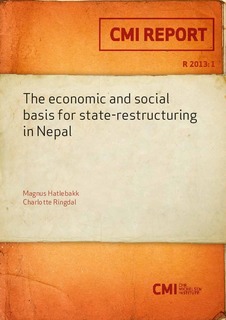The economic and social basis for state-restructuring in Nepal
Research report
Permanent lenke
http://hdl.handle.net/11250/2474944Utgivelsesdato
2013-02-01Metadata
Vis full innførselSamlinger
- Publications [1488]
Originalversjon
Bergen: Chr. Michelsen Institute (CMI Report R 2013:1) 75 p.Sammendrag
Nepal is in the process of forming a federal state, where the borders of the provinces is one essential, but disputed, issue. The report discusses underlying economic and social conditions that should be taken into account when the provinces are formed. More precisely, we describe how the average province poverty levels, and related economic and social indicators, will depend on how the federal map is drawn. The general finding is straight forward, if there is variation in poverty between districts in a specific area, then a large province that includes both poor and rich districts will have the average poverty level of those districts. Since poor and rich districts tend to be geographically clustered, one can end up with poor districts in one province and richer districts in another one if the larger province is split in two. As a result models with a large number of provinces will tend to have a more unequal distribution of poverty between provinces than models with few provinces. The report shows how this argument applies in particular to western Nepal where one may end up with a very poor province in the Karnali region.
